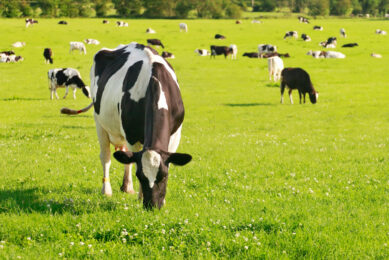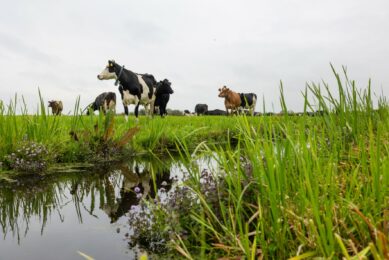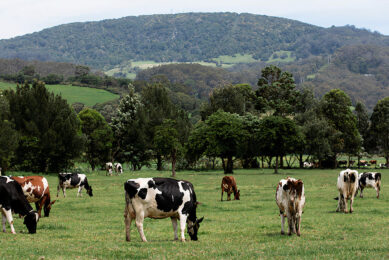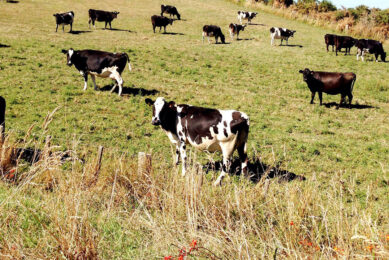Dutch Dairy Campus: Key role in nutrition research
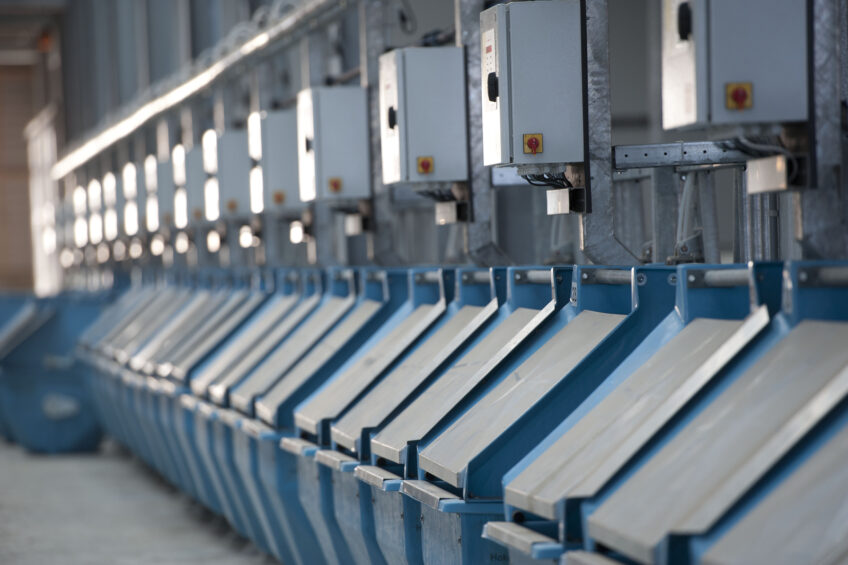
The revamped and expanded Dairy Campus in the Netherlands will have a strong focus on nutrition research. To do so, a brand new barn for 128 cows has been built.
The Dairy Campus is a unique innovation and research centre in Leeuwarden, the Netherlands, that combines scientific research with practical implementation. It also plays an important role in education and training. It is owned by Wageningen University and Research centre (UR), but many partners are involved (such as FrieslandCampina). This unique facility has 550 dairy cows and the barns on the 300 hectare property are all destined for their own research focus (nutrition, environment, welfare).
Nutrition research is an important pillar for the Dairy Campus. “This form of research will remain important, because there is an ongoing demand for new knowledge about cattle feed. The world is always changing; compare the current situation with that of 25 years ago,” says Roselinde Goselink and Gert van Duinkerken, nutritional researchers from Wageningen UR. “The modern cow eats and produces more. And different roughage is used nowadays. Nutrition is the most important factor which the farmer can influence and which also directly affects nutrient utilisation and losses, feed efficiency, animal health and feed costs.”
Research barn
On the Dairy Campus in Leeuwarden, the researchers need to be able to perform this nutrition research in a correct and modern way. This has led to the development of a new state of the art barn. 64 RIC (Roughage Intake Control) troughs from the company Hokofarm Group have been installed. On each side of the feed alley 32 troughs are placed. A RIC trough is enough to feed two cows.
Behind the ‘RIC feeding fence’ are the stalls. For every 8 troughs, there are 16 stalls, with a Hokofarm/SAC concentrate feeding station at the end. This adds up to 8 × 16 = 128 stalls in total. Because of the transverse arrangement, cows can be separated in groups of 16 by dividing fences if a test design requires this. The animals get access to the specific RIC troughs with the right test ration individually. Nedap technique in the neck tags recognises the cows and the contents of the trough is then adapted by the Hokofarm RIC software.
The cow gets access and when she leaves the trough, the weight of this trough is registered again. The difference is the intake by the cow. Besides registering the weight at the start and end, the RIC troughs also register the time at the start and end of the visit. Thus, feed intake and feed intake behaviour can be linked to feeding rate. In the barn, it is possible to exchange 1 trough per 8 for a RIC water trough, to get information on drinking, water intake and drinking rate per animal.
The Nedap neck tags also include a tracking feature which uses GPS to show which cow is where on a barn map on tablet or smartphone. This makes it easier to search for a specific cow. Furthermore, the neck sensor measures draught detection and feed activity, including the number of meals, the meal duration and the interval between meals. Cows can also be equipped with rumen pH boluses that register the acidity of the content of the rumen of the cows.
Additionally there are 16 tie-stalls in the barn for intensive research which cannot be combined with the freedom of movement in the free stalls. Think of when research demands to administer intravenous medicine or to absorb the total manure production for digestive research. The automatic feeding system Triomatic T40 by Trioliet fills the RIC troughs.
Automatic feeding requires less labour. Moreover, the labour is more flexible. The mixing and dosing robot mixes the ration. The robot hangs from a steel rail next to the feed rail, so the mixing can take place during transport. The content of this robot is 3 cubic metres, and with the two vertical screw pumps, small portions starting from 60 kg for a small number of cows, can still be mixed. In theory, each RIC trough could be filled with a different mixture. The software of the RIC trough communicates with the Trioliet-software so that the robot ‘knows’ what troughs it must fill. For the roughage and concentrates, there are five conveyors, which is big enough for several days.
Just outside the barn, the silos with concentrates are located. There are 8 silos with a capacity of 6 tonnes each. Among those, there is a silo with a weighing and mixing unit, control cabinet and control panel. In addition, there are two larger concentrate silos (12 tonnes) and a 30 tonne silo for storage of liquid feed materials. The robot weighs the various components, both roughage as well as concentrates. Minerals are dosed precisely at an intermediate weighing station.
Contract and registration
In contract research, feed products are mostly tested for their effectiveness. “You can think of feed additives or new feed concepts, for example for cows in their transition period,” says Goselink. Agrifirm is one of those contractors. Hendrik Arends, sector manager cattle at Agrifirm explains: “We have not only had Dairy Campus perform nutrition research for years now, but we are also the overall feed supplier on Dairy Campus. Examples of research are the 100-day approach to the dry period and start-up of dairy cattle, the TopStart-concept for substantial higher milk production per cow, as well as DairyStart for the rearing from calve to strong heifer in 22 to 24 months. We not only care about delivering pelleted feed, but also about offering the farmer a total concept which he uses as a system. This is how you contribute to the improvement of the technical and financial results of a company. Immediately after the opening of the Dairy Campus, Agrifirm started with research on the effect of processed raw materials on cow performance and smart individual feeding. This may lead to the reduction in feed costs or enhance nutrients and mineral efficiency.”
The nutrition research is also utilised for registration studies because producers are obliged to have independent institutes do nutrition research before the admission of animal feed additives to the European market. Wageningen UR is often approached for this. The admission of a product on the European market lies with the EFSA (European Food Safety Authority). The conclusions and findings of this kind of research are delivered to the client, who includes the results in the file for EFSA.
| Special place for research on outdoor grazing Outdoor grazing is one of the spearheads in various funds. ZuivelNL has named it one of the most important themes. The Melkveefonds also deems research and more knowledge about grazing weighs imperative. Outdoor grazing supports the image of dairy farming and is an icon of the Dutch dairy sector, both nationally and internationally. This is one of the reasons that Dairy Campus makes space for research on grazing. In nutrition research, it makes sense to know how much grass cows take in outdoors, how you can influence this, and how that grass is utilised. Roselinde Goselink explains what the grazing research focuses on. “In the current grazing trials, we look at the effects of strip grazing versus paddock grazing. In doing so, we try to get the maximum intake.” We can control this by varying the grass supply and the amount and type of extra feeding. The intake of the group is determined by first determining the grass yield and measuring it again after grazing. Furthermore, an indigestible marker substance is added to the concentrate feed of the cows. As the total intake of grass by the cows increases, the concentration of this marker substance in the manure decreases. Because it is known how much roughage and concentrates the cows are offered, the dilution of the marker substance can be used to calculate the intake of fresh grass per individual cow. Feed efficiency on fresh grass is still quite a ‘blind spot’. Everything that contributes to shed more light on this subject, contributes to keeping the cow in the meadow. Van Duinkerken adds, “If you want to measure the effects, you should take the seasonal effects into account, the growth stage of the grass and the weather. To compare different systems with each other, this type of research takes about three years to complete.” |
Funds
The research project ‘Why Dry’, focused on the possibilities and effects of short dry periods or even the continuous milking of cows, was one of the main projects that was run in Lelystad, the Netherlands, a former location of Dairy Campus. The follow-up project ‘Droogstand op Maat’ (Tailor-Made Dry Periods) was also performed here. Research on extra exercise for dry cows under the name ‘Zwangerschapsgym’ (Gestation Gym), received a lot of attention from the field. Deploying a step mill for cows was an innovative research method. Because of this research, many farmers now implement free ranging for their dry cows. This extra movement reduces the number of health problems in early lactation.
For the financing of these types of projects with practical impact there are three main clients. The best known to the farmers is ZuivelNL. This chain organisation of the dairy sector was founded by LTO Netherlands and the Nederlandse Zuivelorganisatie (NZO) (Dutch Dairy Organization) in 2014. “The research of ZuivelNL partly aim for the same goals as the platform ‘Duurzame zuivelketen’ (Sustainable dairy chain): climate-neutral development, improvement of animal welfare, the preservation of outdoor grazing and conservation of biodiversity and environment,” says van Duinkerken.
In addition, there is the Innovatiefonds Dairy Campus (Innovation fund Dairy Campus), where the research is often set up and completed in collaboration with the industry and small- and medium-sized enterprises. This is focused more on innovation projects and on developing new concepts and techniques.
Then there’s the Zuivelfonds (Dairy Fund), filled with money from the sale of the former regional research farms. Also here, attention is being paid to research questions for the dairy farms of the future, such as grass and grazing, manure and fertilisation, lifetime dairy cattle and ‘smart farming’. The Zuivelfonds is managed by LTO and Wageningen UR.
Join 13,000+ subscribers
Subscribe to our newsletter to stay updated about all the need-to-know content in the dairy sector, two times a week.






